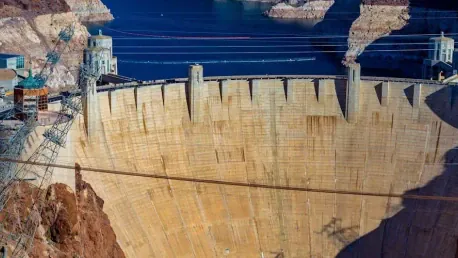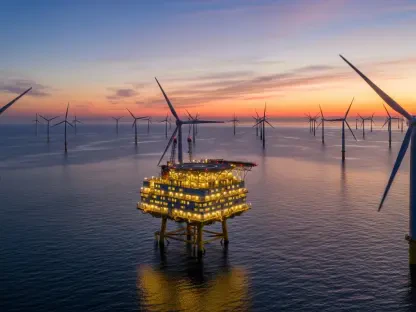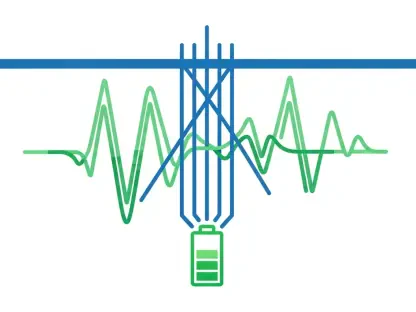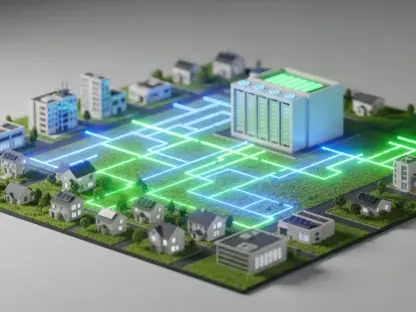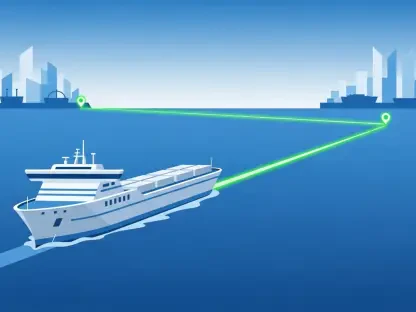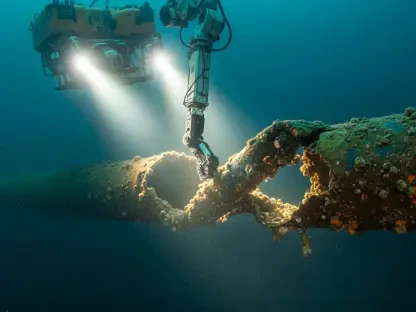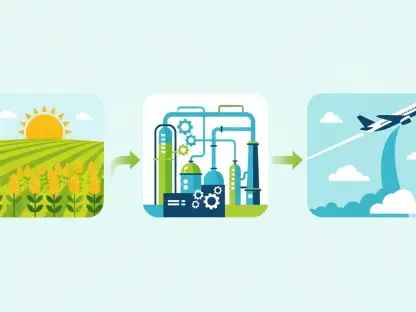Hydroelectric energy, often described as the “backbone of clean power,” is a significant global energy source. It generates over 4,300 TWh annually, enough to meet the energy demands of the entire United States, which used 4,070 TWh in 2022. However, the potential for building new hydroelectric dams is almost entirely tapped in many developed regions such as North America and Europe. Existing dams face limitations due to environmental concerns and substantial construction costs, prompting a focus on maximizing the efficiency of current infrastructure.
The Role of Vortex Engineering in Hydroelectric Systems
Traditional Hydroelectric Systems
Traditional hydroelectric systems involve water flowing down through a penstock to turn a turbine using gravitational force. This method has been the cornerstone of hydroelectric power for decades, providing a stable and continuous electricity supply. Despite the longevity and reliability of these systems, their efficiency has stagnated over time, with only marginal improvements being incorporated. One such improvement involves the use of friction reduction materials within the turbines and penstocks, reducing resistance as water flows through.
However, these incremental changes have not resulted in substantial efficiency gains. As environmental concerns and economic constraints limit the development of new dams, the focus has increasingly shifted to optimizing existing structures. In this context, a greater emphasis is being placed on innovative means of increasing efficiency to make the most of every drop of water. Efforts to enhance efficiency through advanced turbine designs and improved water management controls have been beneficial, but further possibilities warrant exploration.
Introduction to Vortex Hydroelectric Systems
Vortex hydroelectric systems create a whirlpool as water enters, utilizing both gravitational and additional forces for energy production. Unlike traditional methods, which solely depend on gravity, vortex systems capitalize on the physics of fluid dynamics to enhance energy capture. Engineers are now exploring vortex engineering’s potential to harness more power from water, potentially transforming long-standing hydroelectric principles. This innovative approach shows considerable promise, with tests demonstrating that vortex turbines can boost existing systems’ efficiency by at least 10%.
Recent technological advancements have enabled vortex engineering to be scaled up from small experimental setups to more prominent applications. The development of more robust vortex turbines capable of handling higher flow rates has opened possibilities for retrofitting existing hydroelectric plants or integrating vortex technologies into new projects. With enhanced scalability, the economic feasibility and practicality of vortex systems are becoming increasingly apparent.
Recent Advancements in Vortex Technology
While vortex hydroelectric power has been operational on a small scale in various countries, recent advancements have enabled its application on a larger scale. David Sattler, a vortex engineering specialist, equates the new approach to harnessing the power akin to that of a tornado. This method initiates with spinning water in a cylinder as it flows downriver, mimicking water’s downward spiral in a drain. The result is a substantial increase in energy retention and conversion, making vortex systems particularly attractive for efficiency-focused upgrades.
The breakthroughs in vortex technology have largely been driven by better understanding of fluid dynamics and advancements in materials science. Enhancements in computation and simulation have also played critical roles, allowing engineers to model and optimize vortex formation and its interaction with turbines more precisely. Better materials and precise construction have mitigated the earlier issues of wear and inefficiency. These advancements facilitate the effective implementation of vortex systems in various environments, from large rivers to smaller streams, proving their versatile application.
The Urgent Need for Enhanced Hydroelectric Efficiency
Projected Growth Requirements
Despite hydroelectric power’s importance, the EIA highlights an urgent growth requirement, projecting a need for a 4% annual increase in generation to achieve 5,500 TWh by 2030. The growth rate over the past five years has, unfortunately, fallen short of this target, underscoring the necessity for renewed effort and innovation within the sector. Meeting this demand will be crucial for ensuring a sustainable energy future, particularly as global populations and industrial activities continue to rise.
Hydroelectric power holds a critical place in the broader strategy to reduce dependency on fossil fuels and lower greenhouse gas emissions. However, stagnation in growth and efficiency puts pressure on finding alternative or supplemental sources of clean energy. Addressing this need through innovation in existing hydroelectric systems, such as integrating vortex technology, presents a viable and environmentally friendly path forward. Policies and investments that support these enhancements can catalyze significant contributions to projected power requirements.
Historical Design Principles and Room for Improvement
Historically, the design principles for hydroelectric systems have remained largely consistent over several decades. Some advancements, such as friction reduction within penstocks using PTFE and upgrades in turbines, generators, or electronics, have been incorporated. Nevertheless, despite these updates, significant room for improvement remains. With potential constraints on new construction projects and environmental regulations tightening, optimizing existing infrastructures has become imperative.
Incorporating vortex technology is viewed as a promising path to addressing these design limitations. The technology leverages intrinsic properties of fluid dynamics previously overlooked, effectively increasing water’s kinetic energy utilized in power generation. The potential to retrofit older plants without extensive infrastructural changes positions vortex engineering as an attractive solution for upgrading aging infrastructures. As this field evolves, it is expected that more plants will adopt these enhancements, driving overall sector efficiency.
Advantages of Hydropower and the Potential of Vortex Engineering
Stability and Efficiency of Hydropower
Hydropower boasts several advantages: it provides a stable and continuous electricity supply, unlike wind or solar, which are subject to environmental variability. This stability is critical for supporting grid reliability and ensuring a steady flow of energy. Hydropower’s efficiency, converting water to electricity at an impressive rate of 90%, far surpasses that of other renewable sources, such as solar and wind power, with significantly lower efficiency ranges. These features place hydropower at the forefront of sustainable energy solutions.
Additionally, hydropower plants play a crucial role in energy storage and peak demand response. The ability to quickly adjust water flow allows for real-time energy management, making hydropower a valuable asset in maintaining grid stability and security. This capability is particularly important as countries aim to transition to cleaner energy grids that rely more heavily on intermittent renewable sources like wind and solar. Thus, integrating hydropower and enhancing its efficiency can provide much-needed balance and reliability within modern energy systems.
Longevity and Environmental Benefits
Hydropower plants typically have long lifespans, often exceeding 50 years, making them more durable and cost-effective compared to wind and solar installations. The extended operational lifetime translates to lower long-term costs and less frequent need for replacements or upgrades. Additionally, hydropower stands out for its low emissions and waste generation. By utilizing water to generate electricity without burning fossil fuels, hydropower significantly reduces greenhouse gas emissions, contributing to the fight against climate change.
Environmental benefits of hydropower also include supporting local ecosystems. Managed effectively, hydropower plants can create reservoirs that provide habitats for wildlife, promote recreational activities, and support agriculture through reliable water supplies. However, these environmental benefits must be balanced against potential impacts on natural river systems, which is why the move towards more efficient and less intrusive technologies, such as vortex engineering, is gaining traction.
Challenges and Opportunities in Vortex Engineering
Harnessing the Power of Vortexes
Vortex engineering presents a novel and promising approach within this field. Traditionally, engineers have aimed to eliminate vortexes in hydroelectric systems, viewing them as inefficiencies. However, recent insights into the math and physics reveal that vortexes can provide significant energy. Sattler’s team at Marstecs has increased mass flow rate through the penstock by up to 10%, thereby capturing more electrical energy. This innovative rethinking signifies a pivotal shift in how engineers approach hydroelectric power generation, challenging traditional notions of efficiency.
Harnessing the power of vortexes involves sophisticated modeling and precise engineering to create consistent, controlled conditions where the natural formation of whirlpools can be effectively utilized. The controlled vortex flow not only increases water’s velocity but also generates additional kinetic forces that turbines can capture. These optimizations result in higher overall energy output from the same volume of water, proving particularly beneficial for enhancing the capacity of existing hydroelectric plants without requiring extensive reconstructions or new dams.
Retrofitting and New Constructions
The vortex engineering method could be retrofitted onto existing hydroelectric systems or included in new constructions, potentially doubling or tripling the output of traditional systems. Despite this potential, there are notable challenges. For instance, the Lake Peigneur incident in 1980, where a miscalculation resulted in a massive whirlpool, highlights the immense power and potential dangers of vortexes. Effective management and control of vortex systems are crucial, but contemporary advancements ensure safety and reliability similar to other power generation methods.
Navigating these challenges involves developing standardized protocols for designing, installing, and maintaining vortex systems. Ensuring proper training for engineers and operators, along with comprehensive safety measures, can mitigate risks associated with vortex engineering. The ongoing research and development in this field are critical for refining these protocols and advancing the technology’s reliability. By addressing these challenges, vortex engineering could usher in a new era of highly efficient, safe, and sustainable hydroelectric power generation.
Conclusion
Hydroelectric energy, often called the “backbone of clean power,” plays a pivotal role as a global energy source. It produces more than 4,300 TWh of electricity each year, which is sufficient to satisfy the entire energy consumption of the United States, which recorded a usage of 4,070 TWh in 2022. Despite its significant contribution, the possibility of constructing new hydroelectric dams is nearly exhausted in many developed areas, such as North America and Europe. These regions have already exploited much of their suitable sites. Moreover, the development of new dams is hindered by environmental concerns and the high costs associated with construction. As a result, there is now an emphasis on optimizing the efficiency of existing hydroelectric infrastructure. Efforts are focused on technological advancements and improved management practices to enhance the performance and output of current dams. This shift in focus aims to sustain hydroelectric power as a substantial clean energy source while addressing environmental and economic challenges.
